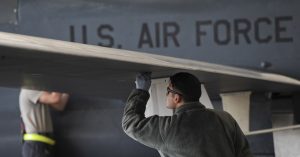What would a ‘war’ between Venezuela and the US look like?

The USS Gerald R. Ford, the world’s largest and most powerful aircraft carrier, is now operating in the Caribbean. It joins a rapidly expanding U.S. military presence that has drawn sharp warnings from Caracas and sparked questions in Washington about whether President Donald Trump is preparing for war with Venezuela.
According to the Pentagon, the Ford and its strike group were deployed to “combat narcoterrorism and drug smuggling” in the Caribbean and eastern Pacific. But the sheer scale of U.S. forces now massed near Venezuelan waters suggests a broader mission.
Alongside the carrier’s 4,500 sailors in the Caribbean are roughly 10,000 additional personnel aboard an amphibious ready group, guided-missile destroyers, and the special operations support vessel MV Ocean Trader. The U.S. also has at least one nuclear-powered submarine in the area, and ten F-35B stealth fighters stationed in Puerto Rico.
The Center for Strategic and International Studies (CSIS) reports the buildup, which started as a counter-drug operation, now has “the hallmarks of a force positioned for sustained strike operations.”
From drug boats to regime targets
U.S. naval forces first began targeting alleged cartel boats in September, killing more than 75 people in strikes off Venezuela’s coast, according to TIME and The Washington Post. The administration insists the campaign is aimed at drug smugglers, but analysts note the attacks have taken place uncomfortably close to Venezuelan territory.
Trump has accused President Nicolás Maduro and senior officials of leading a narcotics network known as the Cartel de los Soles, calling them “narcoterrorists.” That designation could provide the legal framework for a U.S. military strike directly against the Maduro regime. The President has stated explicitly striking targets within Venezuelan territory remains an option.
“The game here is to convince Maduro that his days are numbered,” said retired Adm. James Stavridis, who once oversaw U.S. Southern Command. “Look for precision strikes against narcotics targets and military capability. And, if that doesn’t have the desired effect, against leadership.”
What a conflict could look like
Experts agree that a full-scale U.S. invasion is unlikely. Current American troop levels – about 14,000 in total – fall well short of the force size typically needed for a land campaign. But the United States has deployed enough air and naval firepower to carry out a rapid series of long-range missile and precision airstrikes.
CSIS analysts estimate that by the time the Ford arrived, U.S. forces in the Caribbean had access to roughly 170 Tomahawk cruise missiles – comparable to the arsenal used in the 2011 intervention in Libya. Additional Joint Air-to-Surface Standoff Missiles (JASSMs) and precision-guided bombs could be launched from F-35s and carrier-based aircraft.
Venezuela’s air defenses, largely Russian-made S-300VM and Buk-M2 systems, are mobile but aging. Their performance in Ukraine suggests they would struggle against modern U.S. stealth aircraft and electronic warfare tactics. Venezuela’s fleet of Russian Su-30s and aging F-16s is also mostly non-operational.
During previous interviews on the subject with SAN, multiple experts said the Venezuelan military doesn’t pose much of a threat to the U.S., and any sustained conflict would likely see the U.S. establish air and sea dominance within days.
Caracas on edge
This week, Venezuelan Defense Minister Vladimir Padrino López put the nation’s armed forces on “full operational readiness,” calling for the mobilization of land, air, riverine, and missile units. Civilian militias – part of a “peasant defense” force created under Hugo Chávez – have also been activated, with some 340,000 troops and volunteers reportedly on standby.
According to TIME, Venezuela has even trained for guerrilla resistance in the event of a U.S. invasion, including dispersing small combat units across more than 280 sites for a “prolonged resistance.”
Limited strikes, unlimited consequences
If the Trump administration moves forward, most analysts predict an initial wave of long-range missile and drone attacks against military airfields, radar sites, and joint cartel-military facilities. The aim, according to CSIS, would be to “paralyze and destabilize the Maduro regime” while avoiding large-scale civilian casualties.
But even precision strikes carry political risks. Quoting former U.S. military and intelligence officials, The Washington Post reported that hitting cartel or military sites is unlikely to significantly reduce drug flows to the U.S. and could instead entrench Maduro’s hold on power by framing the conflict as a nationalist defense.
One retired general called the idea that strikes in Venezuela would meaningfully disrupt the drug trade “nonsense.”
A dangerous crossroads
Inside the Trump administration, there are reportedly divisions over the next steps. Secretary of State Marco Rubio and Defense Secretary Pete Hegseth recently told lawmakers the administration lacks a clear legal justification for strikes inside Venezuela.
Still, President Trump has left the door open. In a recent interview with 60 Minutes, he said he doubted a war was imminent but warned that Maduro’s days “are numbered.”
As CSIS analysts put it, “The United States is like an archer with an arrow drawn. The stance is unstable: either launch or stand down.”
The post What would a ‘war’ between Venezuela and the US look like? appeared first on Straight Arrow News.





